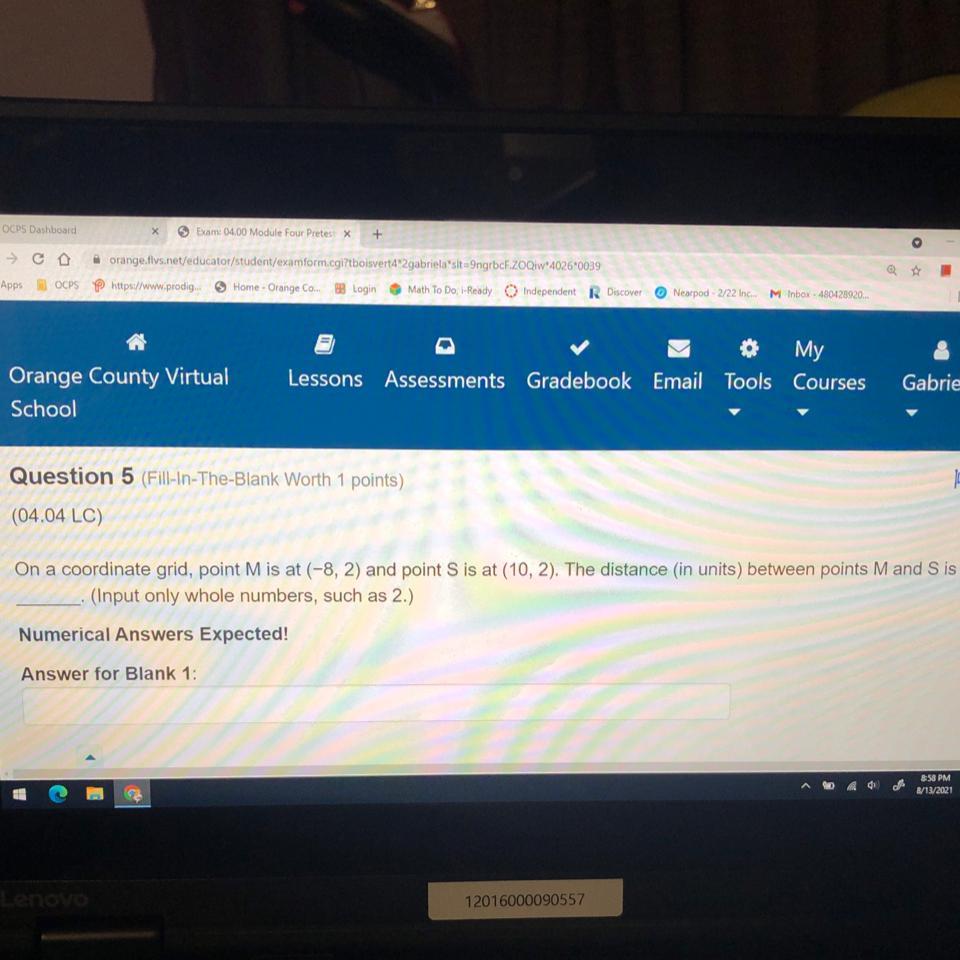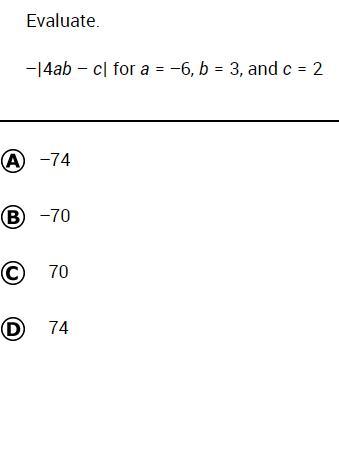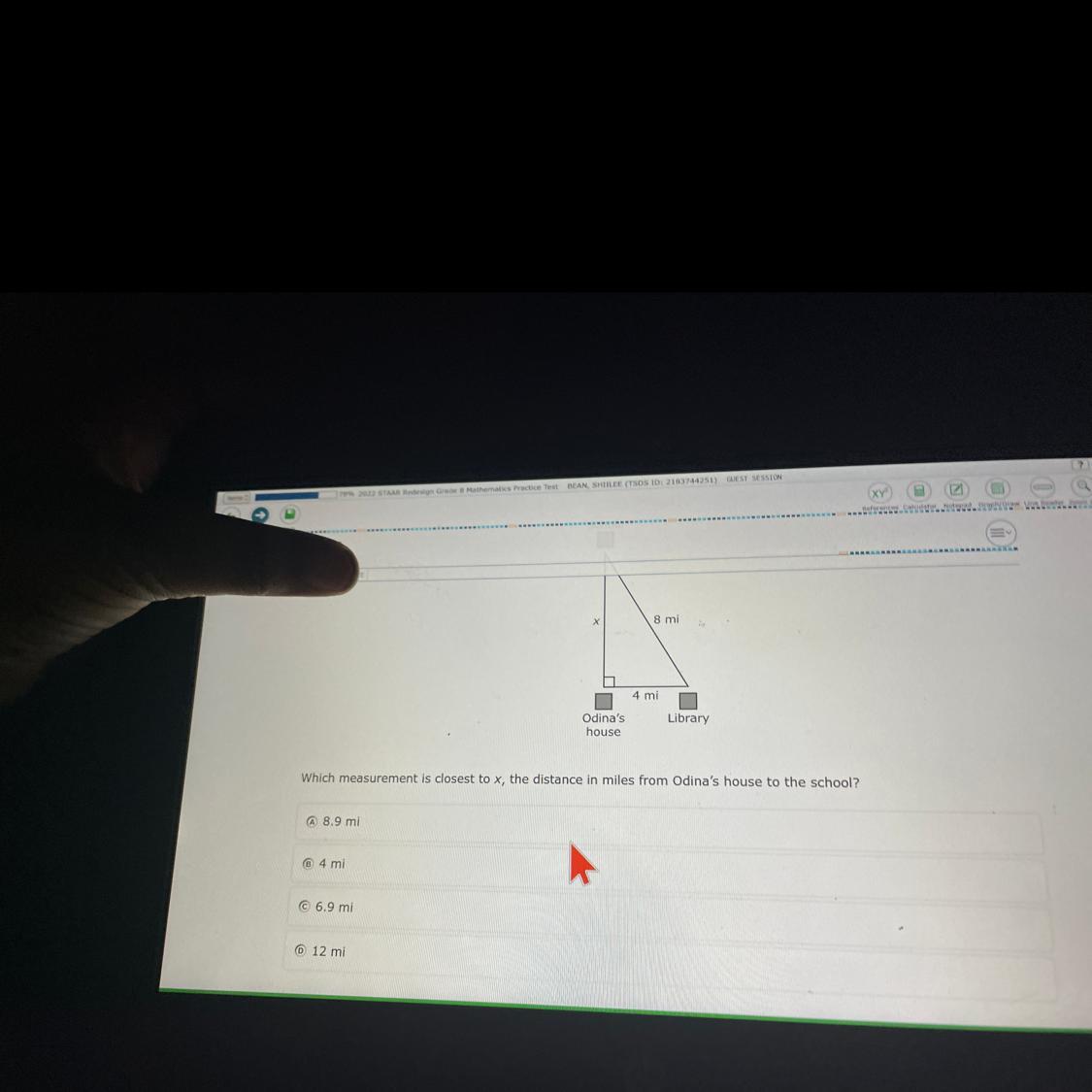Answers
Related Questions
Solve the linear equation 17 - x = ⅓ times 15 + 6. State the property that justifies your first step and why you chose it.
Answers
Answer:17−x=13=x=50
Step-by-step explanation:15+6=21
Finding the area of a circle and a square (and shaded areas), three problems.

Answers
Answer:
B
Step-by-step explanation:
PLEASE ANSWER QUICKLY!!! WILL GIVE BRAINLIEST
10n-7=-(-9n)-26
show work or explain, but please try to do it efficiently. thank you!!
Answers
Answer:
n = -19
Step-by-step explanation:
10n - 7 = -(-9n) - 26
Move all like terms to one side of the equation or the other.
-7 + 26 = -(-9n) - 10n
Combine all like terms.
19 = -(-9n) - 10n
Two minus signs = a positive
19 = 9n - 10
19 = -n
Divide by -1
-19 = n
Hope this helps!
What value of c is a solution to this equation?
–5=–3(c–2)–8
Answers
Answer:c=1
Step-by-step explanation:Step 1: Simplify both sides of the equation.
−5=−3(c−2)−8
−5=(−3)(c)+(−3)(−2)+−8(Distribute)
−5=−3c+6+−8
−5=(−3c)+(6+−8)(Combine Like Terms)
−5=−3c+−2
−5=−3c−2
Step 2: Flip the equation.
−3c−2=−5
Step 3: Add 2 to both sides.
−3c−2+2=−5+2
−3c=−3
Step 4: Divide both sides by -3.
−3c
−3
=
−3
−3
c=1
I’m pretty sure it’s right
1 Three friends ate at a restaurant. They ordered nachos for $17.95 and jalapeno poppers. Each friend paid $8.94, not including sales tax or tip, which was one third of the total. Determine the cost of the jalapeno poppers.
$26.82
$17.74
$8.87
$5.98
Answers
Answer:
The jalapeno poppers cost: $8.87
Step-by-step explanation:
Step 1: How much did all friend pay total: $8.94 * 3 friends = $26.82
Step 2: How much were the jalapeno poppers? We need to subtract the nacho cost from the total paid by the friends: $26.82 - $17.95 = $26.82 = $8.87
(PLS HELP MY TEACHER WANTS ME TO PASS THIS!!)
Which relation is NOT a function?
A. {(0, 0), (1, 1), (1, 2)}
B. {(0, 1), (2, 2), (3, 1)}
C. {(1, 0), (3, 3), (0, 1), (2, 3)}
D. {(3, 8), (6, 11), (8, 3), (11, 6)}
Answers
Answer:
A
Step-by-step explanation:
Because 1 has more than one output, first they are putting 1 and 1 together, next they are putting it with 2, 1 has more than one output.
Answer:A has 2 pairs of "1" x-coordinates so it is NOT a function.
Step-by-step explanation:
In the equation |4x+7|=|19−2x|, what is the sum of all possible values of x?
Answers
Explanation:
4x2=8+7=15
2x2=4-19=15
4(2)+7=15
19-2(2)=15
Aliya made 8 liters of punch for a party. Did she make more than, less than, or exactly 800 milliliters? Explain your answer
Answers
Answer:
more than
Step-by-step explanation:
8 liters
We know that 1000 mL = 1 liter
8 liters * 1000ml / 1 liter = 8000 ML
That is more than 800 mL
help im brain dead or im just dumb

Answers
Answer:
2
Step-by-step explanation:
There are four giraffes that equal 32. That means the four of them equal 32, and since they are all giraffes, they are the same amount.
32/4 = 8
Girrafe = 8
Two tigers times a giraffe equals 32. We already know that a girrafe equals 8.
32/8 = 4.
Therefore the two tigers equal 4. Since there are two tigers, and they equal 4, each tiger equals 2.
Now we know girrafes equal 8, and tigers equal 2.
A girrafe - A tiger x 3 = 2
PEMDAS says that you multiply first. So 2 x 3 equals 6. Take away 6 from 8 and you get 2.
Please help me! Greatly appreciated

Answers
Answer: 18
Step-by-step explanation: -8,2 is 18 away from 10,2 because -8 is 18 away from 10
The ratio of the perimeter of a regular hexagon to the length of one of its sides is always 6 to 1.
Complete the table.
Perimeter of hexagon (inches) 6 30 48
Side length of hexagon (inches) 1
9
Answers
Answer:
45
Step-by-step explanation:
6+30+48-1-9=45
Explanation: adding all number together equal 45
750 divided by 10 to the 3rd power
Answers
Answer:
0.75
Step-by-step explanation:
A television set may be described in terms of the diagonal measure of it's screen.If a TV screen is 16 inched by 12 inches,what is the length of it's diagonal?
Answers
D^2 = (15)^2 + (20)^2
D^2 = 225 + 400
D^2 = 625
square 625 and you get 25 so 25 inches is the answer
3.9y + 3 - 2.9y=
anybody know?!
Answers
Answer:
= y + 3
Step-by-step explanation:
Group:
= 3.9y - 2.9y + 3
Add elements together:
= y + 3
Arrange equation so that like terms are next to each other
3.9y - 2.9y + 3
Subtract.
1y + 3
Since 1y and 3 are not like terms, we cannot add them.
Therefore, 1y + 3 is the answer.
You can also write y +3.
Here are several function rules. Calculate the output for each rule when you use -6 as the input.

Answers
Answer:
1) -13
2) 36
3) -2
4) -5
5) -6
6) -216
Step-by-step explanation:
The output for the considered rules are: Rule 1: -13, Rule 2: 36, Rule 3: -2, Rule 4: -2, Rule 5: π, Rule 6: 216 cubic cm.
What is a function?Function is a type of relation, or rule, that maps one input to specific single output.
We're given that:
Input = -6Applying all the rules, one by one:
Rule 1: Subtract -7
\(\rm \text{inp}ut -7 = -6 -7 = -13\)
Rule 2: Square the input\(\rm (\text{inp}ut )^2 = (-6)^2 = -6\times -6 = 36\)
Rule 3: Divide by 3\(\rm \dfrac{\text{inp}ut }{3} = \dfrac{-6}{3} = -2\)
Rule 4: Divide the input in 3Dividing something in x parts means that thing divided by x
\(\rm \dfrac{\text{inp}ut }{3} = \dfrac{-6}{3} = -2\)
Rule 5: Write π\(\pi\) (no use of input).These type of functions which always give same constant result, no matter what the input is, are called constant functions.
Rule 6: Volume of cube with side length as input in cm.Volume of a cube is the cube of its side length (raising it with power 3).
We're specified that:
Side length of the considered cube = input = -6 cm
Since length is a non-negative quantity, so we take absolute value of -6, therefore, we have:
side length of the cube = |-6| = 6 cm
Thus, its volume is:
\(V= (\rm side)^3 = 6^3 = 216 \: \rm cm^3\)
Thus, the output for the considered rules are: Rule 1: -13, Rule 2: 36, Rule 3: -2, Rule 4: -2, Rule 5: π, Rule 6: 216 cubic cm.
Learn more about function here:
https://brainly.com/question/2253924
The equation of a plane which passes through (2,−3,1) and is normal to the line joining the points (3,4,−1) and (2,−1,5) is given by?
Answers
Answer: We can find the equation of a plane in point-normal form, which is given by:
Ax + By + Cz + D = 0
where (A, B, C) is the normal vector to the plane and (x, y, z) are the coordinates of any point on the plane, and D is a constant.
To find the normal vector, we can use the cross product of two vectors that lie on the plane. A convenient choice for these vectors is the direction vector of the line, which is given by:
v = <2-3, -1-4, 5-(-1)> = < -1, -5, 6 >
The normal vector to the plane is given by the cross product of the direction vector of the line and the vector pointing from any point on the line to the point (2,-3,1). Let's call this vector v2 = <2-3, -3-4, 1-(-1)> = < -1, -7, 2>
So the normal vector is given by:
n = v x v2 = ( -52 + 6-7)i + (6*-1 - -12)j + (-1-7 - -5*2)k = (14)i + (-7)j + (-11)k
Given that the point (2,-3,1) lies on the plane, we can substitute these values in the point-normal form equation:
A2 + B-3 + C*1 + D = 0
-142 + -7-3 + -11*1 + D = 0
-28 - 21 - 11 + D = 0
D = 58
So the equation of the plane is :
14x - 7y - 11z + 58 = 0
This is the equation that represents the plane that passes through (2,−3,1) and is normal to the line joining the points (3,4,−1) and (2,−1,5)
Step-by-step explanation:
Determine if (3,4) is a solution to the equation y=x+1.
Answers
Answer:
it is a solution
3=x 4=y
4=3+1
whats the area of this paralellogram?

Answers
ummmm, what?????? could i get some nice help

Answers
Answer:
It is A
Step-by-step explanation:
Answer:
A
Step-by-step explanation:
Please Answer It Fast

Answers
Answer:
8
Step-by-step explanation:
a clock is
12
11 1
10 2
9 3
8 4
7 5
6
The number horizontally opposite of 4 is 8
Answer:
8
Step-by-step explanation:
8 is the answer
evaluate (100+650)-(2 ÷ 300)
Answers
Question:
evaluate (100+650)-(2 ÷ 300)
Answer:
749.99333333333
Step-by-step explanation:
The acronyms for order of operations mean you should solve equations in this order always working left to right in your equation.PEMDAS stands for "Parentheses, Exponents, Multiplication and Division, Addition and Subtraction"You may also see BEDMAS, BODMAS, and GEMDAS as order of operations acronyms. In these acronyms, "brackets" are the same as parentheses, and "order" is the same as exponents. For GEMDAS, "grouping" is like parentheses or brackets.Solve Equation
Input Equation:
(100+650)-(2/300) = (750)-(2/300)
= 750 - (0.0066666666666667)
= 750 - 0.0066666666666667
= 749.99333333333
Hope this Helps you!
Have a great day!
Explanation:
100+650= 750
Now,
2/300= 0.0067
Subtract both; 750-0.0067= 749.993
Help please!!!!!! 8 minutes left

Answers
Answer:
C. 6.9 miles
Step-by-step explanation:
Use Pythagoras theorem!
a^2 = b^2 + c^2 where a is the hypothenuse
rearrange to find x
a^2 - b^2 = c^2
so 8^2 - 4^2 = x^2
64 - 14 = 48
√48 = 6.9 miles :)
HELP ME NOW URGENT Select the table that represents the linear function: (Graph them if necessary)
A: X- 0,1,2,3 Y- 11,7,5,4
B: X- 0,1,2,3 Y- 0,0,-1,-2
C: X- 0,1,2,3 Y- 6,12,18,24
D: X- 0,1,2,3 Y- 3,2,1,0
Answers
Answer:
C
Step-by-step explanation:
HELP PLEASE 20 POINTS The graph shows the prices of different numbers of bushels of corn at a store in the current year. The table shows the prices of different numbers of bushels of corn at the same store in the previous year. A graph shows Number of Bushels on x-axis and Price of Corn in dollars on y-axis. The x-axis scale is shown from 0 to 21 at increments of 3, and the y-axis scale is shown from 0 to 168 at increments of 24. A straight line joins the ordered pairs 3, 24 and 6, 48 and 9, 72 and 12, 96 and 15, 120 and 18, 144. Previous Year Number of Bushels Price of Corn (dollars) 3 21 6 42 9 63 12 84 Part A: Describe in words how you can find the rate of change of a bushel of corn in the current year, and find the value. Part B: How many dollars more is the price of a bushel of corn in the current year than the price of a bushel of corn in the previous year? Show your work. AND IT IS NOT QUESTION AND ANSWER PLEASE LOOK AT THE GRAPH AND READ THE PARAGRAPH

Answers
Answer:
Part A: 8
Part B: $1
Step-by-step explanation:
Part A:
We know that 3 bushels is $24, and that rate remains constant, as the graph has a straight line.
Divide both sides by 3 to get 1 bushel = $8.
We can also double check with the other values: 48/6=$8 per bushel, 72/9=$8 per bushel, and so on.
The rate of change is the slope of a line (how much one value changes when the other value does). In this equation, the equation of the line is y=8x, so the slope is 8. Therefore, the rate of change is 8.
Part B:
In the previous year, each bushel of corn was 21/3, 42/6, etc., or $7 a bushel. This year, it is $8, so $8-$7=$1
Therefore, the price has increased by $1 this year.
Answe
Step-by-step explanation: Part A:
a
For this problem, I would find the rate of change by finding the slope, which is the change in y over the change of x(y2-y1/x2-x1). In this case, for the current year, it would be 24(48-24) (change in y's) divided 3 (6-3)(change in x's), which comes out to 6. Hence, the rate of change for the current year is 6.
Part B:
Using the same method, the rate of change for the previous year would be 7. I found it by using the same equation. It would (42-21=21)(change in y's) / (6-3=3)(change in x's). 21/3 =7. Hence, for the previous year, the rate of change is 7.So the difference between the previous and current year is $1 (7-6).
Describe how you would graph a figure that is translated by (x - 4, y + 2
Answers
Answer:
See the photo to see where its graphed
Step-by-step explanation:

Samantha earns money when she brings home good grades, but loses money when her grades are poor.
The table below shows how much money Samantha earned and lost last week.
Monday: ($2.25)
Tuesday: (-$1.75)
Wednesday-(-$0.25)
Thursday: ($3.00)
Friday: ($1.75)
If Samantha had $40.75 at the beginning of the week, how much did she have at the end of the week?
PLS SHOW YOUR WORK or i'll just take your answer off
Answers
Answer:
$45.75
Step-by-step explanation:
1. Set up the equation: 40.75 + 2.25 - 1.75 - 0.25 + 3 + 1.75 = x
You want to include the amount that she started with which is $40.75 . In this case x is the total amount of money that Samantha has by the end of the week. If Samantha loses money on a certain day you will subtract it, whereas if she gains money you will add it.
2.Simplify: 43 - 1.75 - 0.25 + 3 + 1.75 = x
I just added the 1st two numbers. You can just type this into the calculator if you are comfortable with that or you can solve this by adding and subtracting the numbers on a piece of scratch paper.
3. Simplify: 41.25 - 0.25 + 3 + 1.75 = x
4. Simplify: 41 + 3 + 1.75 = x
5. Simplify: 44 + 1.75 = x
6. Simplify: 45.75 = x
Water makes up about 71% of the Earth's surface, while the other 29% consists of continents and islands. 96% of all Earth's water is contained within the oceans as salt water, while the remaining 4% is fresh water located in lakes, rivers, glaciers, and the polar ice caps.
a. If the total volume of the Earth is 1,386,000,000 km3, the volume of salt water is ? km3.
b. If the total volume of the Earth is 1,386,000,000km3, the volume of fresh water is ? km3.
Answers
The answer to part A is: 944,697,600 km3.
The answer to part B is: 39,362,400 km3.
Hope this helps!
(wrong answer)
20 pts:
Here are points A-E.
a. Which point is the image of B using A as the center of dilation and with a scale factor of 2? Select Choice:
b. Which point is the image of A using B as the center of dilation and with a scale factor of 2? Select Choice:
c. Which point is the image of B using A as the center of dilation and with a scale factor of 1/2? Select Choice:
d. Which point is the image of A using B as the center of dilation and with a scale factor of 1/2? Select Choice:

Answers
Answer:
a's answer = E
b's answer = C
c 's answer= D
d 's answer= A
From the anime Naruto, the character Madara bought two pair of shoes from Nike & Adidas.
The cost of the Nike is
ହ
of Adidas’s cost. If the Nike cost $84, how much is the Adidas?
Write & solve an Algebraic Equation.
Answers
Answer:
$163+x or$163x
Step-by-step explanation:
8. Kennedy wants to use an internet site to sell his game system. The website will charge him a
fee that will be deducted from the selling price.
A. Suppose the fee is 9 1/2 of the selling price. Determine the amount of the fee if
Kennedy sells his system for $50.
B. How much money will Kennedy receive after the fee has been deducted?
9. A recipe that makes 16 cookies calls for
1/4 cup of sugar and 2/3 cup of flour.
A. Using the new recipe, how much flour should she use?
Explain or show your work.
B. How many cookies can she make with the new
recipe? Explain or show your work.
